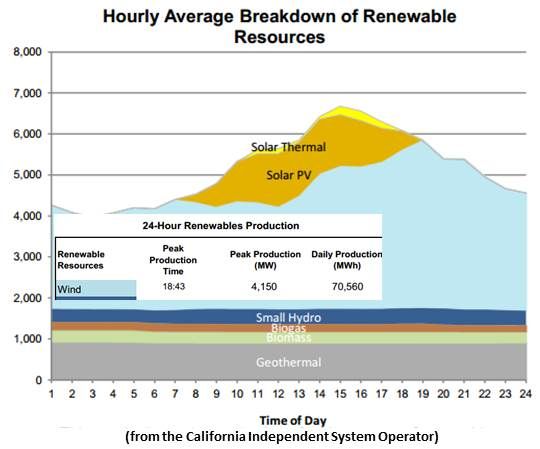Winds that reached over 90 miles per hour on mountain ridges blew down through the wind farms in California’s Altamont, San Gorgonio, and Tehachapi Passes and across the state’s wind installations, raising their outputs to a record-shattering 4,196 megawatts on Sunday evening, according the California Independent System Operator (the ISO).
The output was nearly the equivalent of the combined capacities of San Onofre and Diablo Canyon, California’s two nuclear generating stations.
Peak wind output came at 6:44 PM. Total system generation was 23,923 megawatts at the time, making wind 17.5 percent of the state’s electricity supply.
The total system peak output was 27,426 megawatts at 4:07 p.m. that afternoon. In the hour before that, with the total system producing 23,145 megawatts, California got 6,677 megawatts of its electricity, or 28.8 percent, from renewables.
Renewables constituted the second-largest category of generation during that 3 p.m. to 4 p.m. hour, according to ISO statistics. The category of highest output, at 7,754 megawatts, was imported energy. ISO spokesman Steven Greenlee said that category typically includes mostly natural gas and large hydroelectric power, as well as imported renewables and a small bit of coal grandfathered into the system. The implication is that renewables may have constituted even more than 28.8 percent of California’s electricity during that hour.
The previous wind high, set April 5, was 4,095 megawatts. It was the first time California’s system had ever drawn over 4,000 megawatts from wind. Before that, the record was 3,944 megawatts, achieved on March 13.
The ISO’s total installed wind capacity is 5,899 megawatts, but some of it was in normal maintenance on the date in question.
The specially tasked renewables desk in the Mission Critical Wing of the ISO’s high-tech Folsom, California control center managed the increased levels of wind and renewables without issues, Greenlee said. It is already equipped with system tool access to forecasting capability and real-time five-minute market information, so it is capable of managing even more than the 33 percent renewables mandated for 2020.




